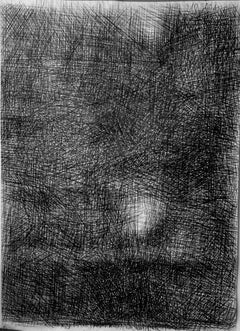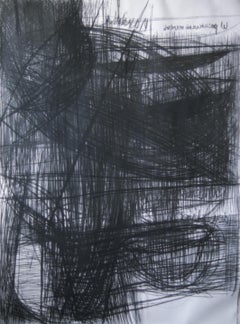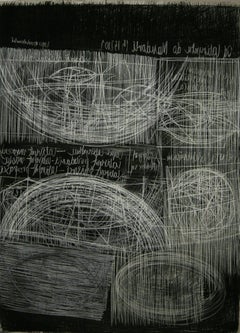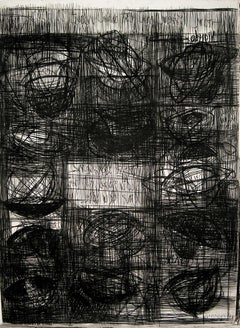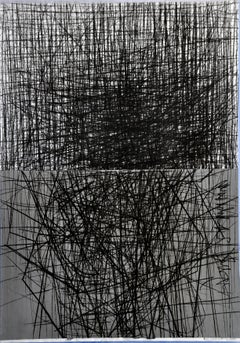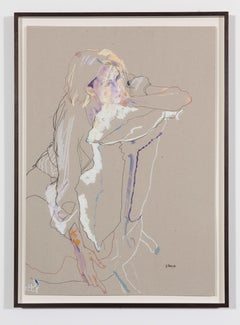Krzysztof Gliszczyński Drawings and Watercolor Paintings
Polish, b. 1962
Krzysztof Gliszczyński is Professor for painting on Academy of fine arts Gdansk.
Krzysztof Gliszczyński born in Miastko in 1962. Graduated from the Gdańsk Academy of Fine Arts in 1987 in the studio of Prof. Kazimierz Ostrowski. Between 1995 and 2002 founder and co-manager of Koło Gallery in Gdańsk. lnitiator of the Kazimierz Ostrowski Award, con-ferred by the Union of Polish Artists and Designers (ZPAP), Gdańsk Chapter. Dean of the Painting Faculty of the Gdańsk Academy of Fine Arts in the years 2008-2012. Vice Rector for Development and Cooperation of the Gdańsk Academy of Fine Arts in the years 2012-2016. Obtained a professorship in 2011. Currently head of the Third Painting Studio of the Painting Faculty of the Gdańsk Academy of Fine Arts. He has taken part in a few dozen exhibitions in Poland and abroad. He has received countless prizes and awards for his artistic work. He is active in the field of painting, drawing, objects, and video.
(Biography provided by Galerie Sandhofer)
to
6
5
1
1
1
4
Overall Height
to
Overall Width
to
1
1
1
6
17
705
407
288
228
6
6
Artist: Krzysztof Gliszczyński
Light, Series Drawing From Israel - Large Format, Charcoal On Paper
By Krzysztof Gliszczyński
Located in Salzburg, AT
The artwork is unframed and will be shipped rolled in a tube
Krzysztof Gliszczyński is Professor for painting on Academy of fine arts Gdansk.
Krzysztof Gliszczyński born in Miastko in 1962. Graduated from the Gdańsk Academy of Fine Arts in 1987 in the studio of Prof. Kazimierz Ostrowski. Between 1995 and 2002 founder and co-manager of Koło Gallery in Gdańsk. lnitiator of the Kazimierz Ostrowski Award, con-ferred by the Union of Polish Artists and Designers (ZPAP), Gdańsk Chapter. Dean of the Painting Faculty of the Gdańsk Academy of Fine Arts in the years 2008-2012. Vice Rector for Development and Cooperation of the Gdańsk Academy of Fine Arts in the years 2012-2016. Obtained a professorship in 2011. Currently head of the Third Painting Studio of the Painting Faculty of the Gdańsk Academy of Fine Arts. He has taken part in a few dozen exhibitions in Poland and abroad. He has received countless prizes and awards for his artistic work. He is active in the field of painting, drawing, objects, and video.
Artist Statement
In the 1990s I started collecting flakes of paint – leftovers from my work. I would put fresh ones in wooden formworks, dried ones in glass containers. They constituted layers of investigations into the field of painting, enclosed in dated and numbered cuboids measuring 47 × 10.5 × 10.5 cm. I called those objects Urns. In 2016, I displayed them at an exhibition, moulding a single object out of all the Urns. The Urns inspired me to redefine the status of my work as a painter. In order to do it, I performed a daunting task of placing the layers of paint not in an urn, but on a canvas, pressing each fresh bit of paint with my thumb. In the cycle of paintings Autoportret a’retour, the matter was transferred from painting to painting, expanding the area of each consecutive one. Together, the bits, the residua of paint, kept alive the memory of the previous works. It was a stage of the atomization of the painting matter and its alienation from the traditional concepts and aesthetic relations. Thus, the cycle of synergic paintings was created, as I called them, guided by the feeling evoked in me by the mutually intensifying flakes of paint. The final aesthetic result of the refining of the digested matter was a consequence of the automatism of the process of layering, thumb-pressing, and scraping off again. Just like in an archaeological excavation, attempts are made to unite and retrieve that which has been lost. This avant-garde concept consists in transferring into the area of painting of matter, virtually degraded and not belonging to the realm of art. And yet the matter re-enters it, acquiring a new meaning. The matter I created, building up like lava, became my new technique. I called it perpetuum pictura – self-perpetuated painting. Alchemical concepts allowed me to identify the process inherent in the emerging matter, to give it direction and meaning. In a way, I created matter which was introducing me into the pre-symbolic world – a world before form, unnamed. From this painterly magma, ideas sprung up, old theories of colour and the convoluted problem of squaring the circle manifested themselves again. Just like Harriot’s crystal refracted light in 1605, I tried to break up colour in the painting Iosis. Paintings were becoming symptoms, like in the work Pulp fiction, which at that time was a gesture of total fragmentation of matter and of transcending its boundaries, my dialogue with the works of Jackson Pollock and the freedom brought by his art. The painting Geometrica de physiologiam pictura contains a diagram in which I enter four colours that constitute an introduction to protopsychology, alchemical transmutation, and the ancient theory of colour. It this work I managed to present the identification of the essence of human physiology with art. But the essential aspect of my considerations in my most recent paintings is the analysis of abstraction, the study of its significance for the contemporary language of art and the search for the possibilities of creating a new message. For me, abstraction is not an end in itself, catering to the largely predicable expectations of the viewers. To study the boundary between visibility and invisibility, like in the work Unsichtbar, is to ask about the status of the possibilities of the language of abstraction. The moment of fluidity which I am able to attain results from the matter – matter...
Category
Early 2000s Conceptual Krzysztof Gliszczyński Drawings and Watercolor Paintings
Materials
Paper, Charcoal
Untitled 1 - Expressive Charcoal On Paper Painting, Black White Drawing
By Krzysztof Gliszczyński
Located in Salzburg, AT
The paper of the work is not yellowed, there is a applied yellowed primer under the drawing
Krzysztof Gliszczyński is Professor for painting o...
Category
Early 2000s Conceptual Krzysztof Gliszczyński Drawings and Watercolor Paintings
Materials
Paper, Charcoal
Mandorla - Large Format Charcoal On Paper, Black White Drawing
By Krzysztof Gliszczyński
Located in Salzburg, AT
Krzysztof Gliszczyński is Professor for painting on Academy of fine arts Gdansk.
The artwork is unframed and will be shipped rolled in a tube
Artist Statement
In the 1990s I started collecting flakes of paint – leftovers from my work. I would put fresh ones in wooden formworks, dried ones in glass containers. They constituted layers of investigations into the field of painting, enclosed in dated and numbered cuboids measuring 47 × 10.5 × 10.5 cm. I called those objects Urns. In 2016, I displayed them at an exhibition, moulding a single object out of all the Urns. The Urns inspired me to redefine the status of my work as a painter. In order to do it, I performed a daunting task of placing the layers of paint not in an urn, but on a canvas, pressing each fresh bit of paint with my thumb. In the cycle of paintings Autoportret a’retour, the matter was transferred from painting to painting, expanding the area of each consecutive one. Together, the bits, the residua of paint, kept alive the memory of the previous works. It was a stage of the atomization of the painting matter and its alienation from the traditional concepts and aesthetic relations. Thus, the cycle of synergic paintings was created, as I called them, guided by the feeling evoked in me by the mutually intensifying flakes of paint. The final aesthetic result of the refining of the digested matter was a consequence of the automatism of the process of layering, thumb-pressing, and scraping off again. Just like in an archaeological excavation, attempts are made to unite and retrieve that which has been lost. This avant-garde concept consists in transferring into the area of painting of matter, virtually degraded and not belonging to the realm of art. And yet the matter re-enters it, acquiring a new meaning. The matter I created, building up like lava, became my new technique. I called it perpetuum pictura – self-perpetuated painting. Alchemical concepts allowed me to identify the process inherent in the emerging matter, to give it direction and meaning. In a way, I created matter which was introducing me into the pre-symbolic world – a world before form, unnamed. From this painterly magma, ideas sprung up, old theories of colour and the convoluted problem of squaring the circle manifested themselves again. Just like Harriot’s crystal refracted light in 1605, I tried to break up colour in the painting Iosis. Paintings were becoming symptoms, like in the work Pulp fiction, which at that time was a gesture of total fragmentation of matter and of transcending its boundaries, my dialogue with the works of Jackson Pollock and the freedom brought by his art. The painting Geometrica de physiologiam pictura contains a diagram in which I enter four colours that constitute an introduction to protopsychology, alchemical transmutation, and the ancient theory of colour. It this work I managed to present the identification of the essence of human physiology with art. But the essential aspect of my considerations in my most recent paintings is the analysis of abstraction, the study of its significance for the contemporary language of art and the search for the possibilities of creating a new message. For me, abstraction is not an end in itself, catering to the largely predicable expectations of the viewers. To study the boundary between visibility and invisibility, like in the work Unsichtbar, is to ask about the status of the possibilities of the language of abstraction. The moment of fluidity which I am able to attain results from the matter – matter...
Category
Early 2000s Conceptual Krzysztof Gliszczyński Drawings and Watercolor Paintings
Materials
Paper, Charcoal
Drawing 14, Series Drawing - Large Format, Charcoal On Paper Panting
By Krzysztof Gliszczyński
Located in Salzburg, AT
The artwork is unframed and will be shipped rolled in a tube
Krzysztof Gliszczyński is Professor for painting on Academy of fine arts Gdansk.
Krzysztof Gliszczyński born in Miastko in 1962. Graduated from the Gdańsk Academy of Fine Arts in 1987 in the studio of Prof. Kazimierz Ostrowski. Between 1995 and 2002 founder and co-manager of Koło Gallery in Gdańsk. lnitiator of the Kazimierz Ostrowski Award, con-ferred by the Union of Polish Artists and Designers (ZPAP), Gdańsk Chapter. Dean of the Painting Faculty of the Gdańsk Academy of Fine Arts in the years 2008-2012. Vice Rector for Development and Cooperation of the Gdańsk Academy of Fine Arts in the years 2012-2016. Obtained a professorship in 2011. Currently head of the Third Painting Studio of the Painting Faculty of the Gdańsk Academy of Fine Arts. He has taken part in a few dozen exhibitions in Poland and abroad. He has received countless prizes and awards for his artistic work. He is active in the field of painting, drawing, objects, and video.
Artist Statement
In the 1990s I started collecting flakes of paint – leftovers from my work. I would put fresh ones in wooden formworks, dried ones in glass containers. They constituted layers of investigations into the field of painting, enclosed in dated and numbered cuboids measuring 47 × 10.5 × 10.5 cm. I called those objects Urns. In 2016, I displayed them at an exhibition, moulding a single object out of all the Urns. The Urns inspired me to redefine the status of my work as a painter. In order to do it, I performed a daunting task of placing the layers of paint not in an urn, but on a canvas, pressing each fresh bit of paint with my thumb. In the cycle of paintings Autoportret a’retour, the matter was transferred from painting to painting, expanding the area of each consecutive one. Together, the bits, the residua of paint, kept alive the memory of the previous works. It was a stage of the atomization of the painting matter and its alienation from the traditional concepts and aesthetic relations. Thus, the cycle of synergic paintings was created, as I called them, guided by the feeling evoked in me by the mutually intensifying flakes of paint. The final aesthetic result of the refining of the digested matter was a consequence of the automatism of the process of layering, thumb-pressing, and scraping off again. Just like in an archaeological excavation, attempts are made to unite and retrieve that which has been lost. This avant-garde concept consists in transferring into the area of painting of matter, virtually degraded and not belonging to the realm of art. And yet the matter re-enters it, acquiring a new meaning. The matter I created, building up like lava, became my new technique. I called it perpetuum pictura – self-perpetuated painting. Alchemical concepts allowed me to identify the process inherent in the emerging matter, to give it direction and meaning. In a way, I created matter which was introducing me into the pre-symbolic world – a world before form, unnamed. From this painterly magma, ideas sprung up, old theories of colour and the convoluted problem of squaring the circle manifested themselves again. Just like Harriot’s crystal refracted light in 1605, I tried to break up colour in the painting Iosis. Paintings were becoming symptoms, like in the work Pulp fiction, which at that time was a gesture of total fragmentation of matter and of transcending its boundaries, my dialogue with the works of Jackson Pollock and the freedom brought by his art. The painting Geometrica de physiologiam pictura contains a diagram in which I enter four colours that constitute an introduction to protopsychology, alchemical transmutation, and the ancient theory of colour. It this work I managed to present the identification of the essence of human physiology with art. But the essential aspect of my considerations in my most recent paintings is the analysis of abstraction, the study of its significance for the contemporary language of art and the search for the possibilities of creating a new message. For me, abstraction is not an end in itself, catering to the largely predicable expectations of the viewers. To study the boundary between visibility and invisibility, like in the work Unsichtbar, is to ask about the status of the possibilities of the language of abstraction. The moment of fluidity which I am able to attain results from the matter – matter...
Category
Early 2000s Conceptual Krzysztof Gliszczyński Drawings and Watercolor Paintings
Materials
Charcoal, Paper
Drawing 13, Series Drawing - Large Format, Charcoal On Paper Panting
By Krzysztof Gliszczyński
Located in Salzburg, AT
The artwork is unframed and will be shipped rolled in a tube
Krzysztof Gliszczyński is Professor for painting on Academy of fine arts Gdansk. ...
Category
Early 2000s Conceptual Krzysztof Gliszczyński Drawings and Watercolor Paintings
Materials
Charcoal, Paper
TWO SPACES - Expressive Charcoal On Paper Painting, Black White Drawing
By Krzysztof Gliszczyński
Located in Salzburg, AT
The work is on 1 paper.
Krzysztof Gliszczyński is Professor for painting on Academy of fine arts Gdansk.
The artwork is unframed and will be...
Category
Early 2000s Conceptual Krzysztof Gliszczyński Drawings and Watercolor Paintings
Materials
Paper, Charcoal
Related Items
Freya (Seated Backwards), Mixed media on grey board
By Howard Tangye
Located in London, GB
Howard Tangye (b.1948, Australia) has been an influential force in fashion for decades. Lecturing at London’s Central Saint Martins for 35 years, including 16 years as head of BA Wom...
Category
2010s Contemporary Krzysztof Gliszczyński Drawings and Watercolor Paintings
Materials
Other Medium, Archival Paper, Handmade Paper, Pen, Felt Pen, Permanent M...
Untitled 1 (Modern Black Charcoal & Gray Abstract Still Life Drawing on Paper)
By Ralph Stout
Located in Hudson, NY
18 x 14 inch drawing on 20 x 16 inch Aquarelle Arches Paper
24 x 20 x .5 inches framed
Thin profile black metal frame, 8 ply white mat
Ralph Stout's works on paper reveal a drau...
Category
2010s Abstract Krzysztof Gliszczyński Drawings and Watercolor Paintings
Materials
Archival Paper, Charcoal
H 24 in W 20 in D 0.5 in
"Untitled, " Alan Fenton, Abstract Expressionism
Located in New York, NY
Alan Fenton (1927 - 2000)
Untitled, 1965
Charcoal and graphite on paper
23 x 17 inches
Signed and dated lower right
Fenton's quiet and contemplative nonob...
Category
1960s Abstract Expressionist Krzysztof Gliszczyński Drawings and Watercolor Paintings
Materials
Paper, Charcoal, Graphite
"Landscape B/W" Minimalist Drawing Large size Made in Italy
By Marilina Marchica
Located in Agrigento, AG
Landscape B/W
Mineral oxide on paper (300gr)
Minimalism- Original art
75x55 cm
Frame
90x70 cm
Original Created:2022
Subjects:Landscape
Materials:Paper
Styles:#Abstract #AbstractExp...
Category
2010s Contemporary Krzysztof Gliszczyński Drawings and Watercolor Paintings
Materials
Charcoal, Paper
H 35.44 in W 27.56 in D 1.97 in
Untitled (Modern Black Charcoal & Gray Abstract Still Life Drawing on Paper)
By Ralph Stout
Located in Hudson, NY
18 x 14 inch drawing on 20 x 16 inch Aquarelle Arches Paper
24 x 20 x .5 inches framed
Thin profile black metal frame, 8 ply white mat
Ralph Stout's works on paper reveal a drau...
Category
Early 2000s Abstract Krzysztof Gliszczyński Drawings and Watercolor Paintings
Materials
Archival Paper, Charcoal
H 24 in W 20 in D 0.5 in
Natasha (Sitting), Mixed media on Pergamenata parchment
By Howard Tangye
Located in London, GB
Howard Tangye (b.1948, Australia) has been an influential force in fashion for decades. Lecturing at London’s Central Saint Martins for 35 years, including 16 years as head of BA Womenswear. There, he tutored many contemporary greats, including John Galliano, Stella McCartney, Christopher Kane, Wes Gordon, Zac Posen and Hussein Chalayan.
Examples of Tangye’s portraits are held in many important collections, both public and private, including the Victoria and Albert Museum (V&A), Harvard University and London’s National Portrait Gallery.
Throughout his teaching career Tangye quietly developed a particularly idiosyncratic art practice. By employing a decisive line with bold applications of richly layered materials, Tangye explores the nuances of the human form in an effort to expose his subjects’ true essence and energy.
—
Howard Tangye
Natasha (Sitting), 2012
Mixed media on Pergamenata parchment
100 x 70 cm (39.37 x 27.55 in)
(signed) (unframed)
—
This portrait shows Natasha, an ex-student and model. Here she’s posed in Howard’s studio wearing a look from Louise Gray’s S/S 2013 collection. The collection featured headwear by Stephen Jones, the renowned British milliner who created the cut-out plexiglass fascinator Natasha wears here.
This work hails from a series commissioned by Dan Thawley, director of “A Magazine Curated By” for the edition guest edition by Jones who dedicated his issue to Anna Piaggi...
Category
2010s Contemporary Krzysztof Gliszczyński Drawings and Watercolor Paintings
Materials
Gesso, Paint, Paper, Parchment Paper, Chalk, Charcoal, Crayon, Oil Crayo...
Untitled 24 (Modern Black Charcoal & Gray Abstract Still Life Drawing on Paper)
By Ralph Stout
Located in Hudson, NY
18 x 14 inch drawing on 20 x 16 inch Aquarelle Arches Paper
24 x 20 x .5 inches framed
Thin profile black metal frame, 8 ply white mat
Ralph Stout's works on paper reveal a drau...
Category
Early 2000s Abstract Krzysztof Gliszczyński Drawings and Watercolor Paintings
Materials
Archival Paper, Charcoal
H 24 in W 20 in D 0.5 in
Jake W. (Before Paris II), Mixed media on Fabriano paper
By Howard Tangye
Located in London, GB
Howard Tangye (b.1948, Australia) has been an influential force in fashion for decades. Lecturing at London’s Central Saint Martins for 35 years, includi...
Category
2010s Contemporary Krzysztof Gliszczyński Drawings and Watercolor Paintings
Materials
Felt Pen, Pencil, Carbon Pencil, Color Pencil, Graphite, Gesso, Pigment,...
Landscape Black and White - Original Paint - Large Size Made in Italy
By Marilina Marchica
Located in Agrigento, AG
Landscape B/W
Mineral oxide on Fabriano Rosaspina Paper
57x76 cm
Original Art
Framing Option Available
Marilina Marchica, born in 1984, was born in Agrigento, where she lives and ...
Category
2010s Contemporary Krzysztof Gliszczyński Drawings and Watercolor Paintings
Materials
Paper, Charcoal
No Reserve
H 29.93 in W 22.45 in D 0.79 in
"Repetition" Chryssa, Greek Female Artist, Abstract, Neon Light Art Study
By Chryssa Vardea-Mavromichali
Located in New York, NY
Chryssa
Repetition
Signed lower right; titled on the reverse
Gouache, watercolor, charcoal, and graphite on paper
15 x 11 inches
Born and educated in Athens, Greece, Vardea Chryssa, known professionally as Chryssa, became a U.S. citizen and earned a reputation for her sculptured assemblages utilizing light from neon, and plexiglas combined with mixed media pieces. One of her pieces, Untitled Light Sculpture (1980) is 22 feet long and is installed in the atrium of a building at 33 Monroe Street in Chicago. It was programmed electronically to create changing patterns of reflected light through 900 feet of neon tubing.
Chryssa's sculptures with precision and definite form were a reaction against the prevalent Abstract Expressionism of the 1950s with its emphasis purely upon the artist's intent. In her work, the focus is on materials and the way they are shaped for specific use by craftsmen.
She got her early education in Athens, and first studied to be a social worker. She was then sent by the Greek Ministry of Social Welfare to the Dodecanese Islands and later to the Ionian Sea island of Zante, whose population had suffered great loss from earthquakes. Disillusioned that monies were being provided to restore monasteries but not to help other earthquake victims, Chryssa changed her life's direction to become a painter. In Athens, she studied art with Anghelos Prokopion.
Then she went to Paris, France, and studied briefly at the Academie Grande Chaumiere and associated with surrealists Andre Breton, Edgard Varese, and Max Ernst. In 1954, she moved to San Francisco, California for a year of study at the California School of Fine Arts, and there she first saw the work of Jackson Pollock, which had a freeing affect on her and inspired her to experiment with pure form. But later she reacted against action painting with her assemblage sculptures of controlled precision.
In 1955, Chryssa settled in New York City, and became the first artist to incorporate neon light tubing and commercial signs into sculpture. It is asserted that her "mature work grew out of the Greek experience, before and after World War II, wedded to the raucous letters, signs, symbols, and lights of Time Square, New York City" (Heller 125). In fact, she was so taken with the lights of Times Square that she unsuccessfully tried to get a job as a sign maker but was prevented by labor union rules. However, one of the members gave her sign-making lessons in his shop.
She first made Pop images such as depictions of automobile tires and cigarettes and in sculptures, utilized letters of the alphabet, ideas that predated similar images by Jasper Johns and Andy Warhol. Her first major work of interwoven light and letters was Times Square Sky of 1962, but she was dissatisfied because she thought the piece was too crowded. To create a sense of breathing, she inserted neon light, and for the first time, this material became an art medium.
From that time, she was prolific and created many variations based on the letters W and A. For her, a primary motivating factor was remaining cool or mentally collected amidst the onslaught of bombarding information and to process it through her creations in new ways so that nothing was repeated. She set up her own work place...
Category
Late 20th Century Abstract Krzysztof Gliszczyński Drawings and Watercolor Paintings
Materials
Gouache, Graphite, Paper, Charcoal, Watercolor
Conceptual Text Based Painting "Lousy Director"
By David Kramer
Located in New York, NY
38"x28" signed by the artist, David Kramer. (oil, acrylic, enamel, pencil on gessoed paper) In this conceptual work on paper, the imagery of a film director is overwritten with the ...
Category
2010s Conceptual Krzysztof Gliszczyński Drawings and Watercolor Paintings
Materials
Paper, Oil, Pencil
Oleg (Kimono), Mixed media on ochre parchment paper
By Howard Tangye
Located in London, GB
Howard Tangye (b.1948, Australia) has been an influential force in fashion for decades. Lecturing at London’s Central Saint Martins for 35 years, including 16 years as head of BA Wom...
Category
2010s Contemporary Krzysztof Gliszczyński Drawings and Watercolor Paintings
Materials
Paint, Paper, Parchment Paper, Charcoal, Crayon, Oil Crayon, Oil Pastel,...
Krzysztof Gliszczyński drawings and watercolor paintings for sale on 1stDibs.
Find a wide variety of authentic Krzysztof Gliszczyński drawings and watercolor paintings available for sale on 1stDibs. You can also browse by medium to find art by Krzysztof Gliszczyński in charcoal, paper and more. Not every interior allows for large Krzysztof Gliszczyński drawings and watercolor paintings, so small editions measuring 28 inches across are available. Krzysztof Gliszczyński drawings and watercolor paintings prices can differ depending upon medium, time period and other attributes. On 1stDibs, the price for these items starts at $1,221 and tops out at $2,774, while the average work can sell for $2,774.
